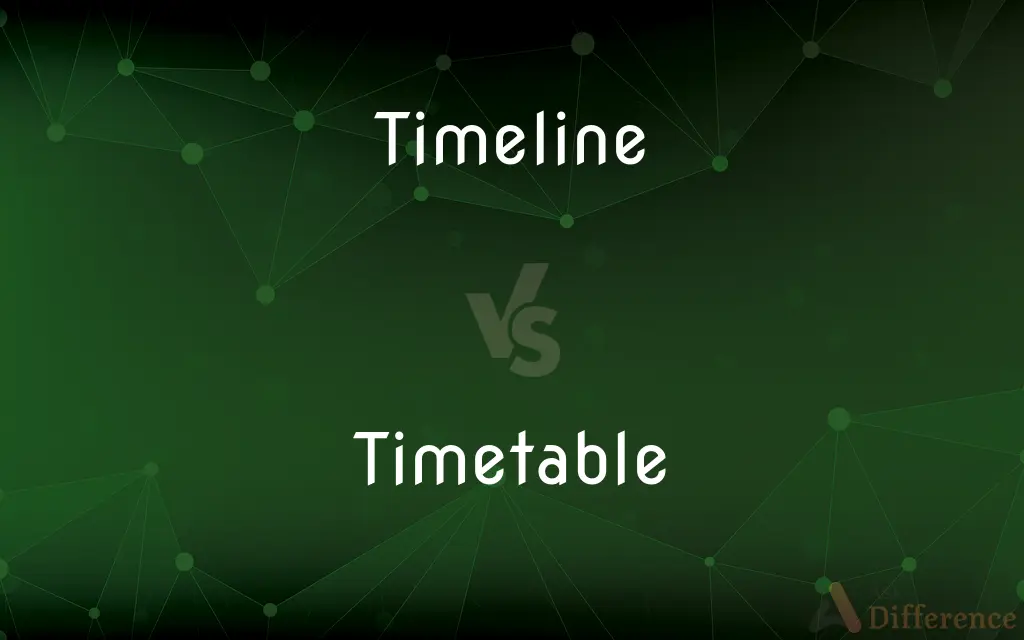Timeline vs. Timetable — What's the Difference?
By Fiza Rafique & Urooj Arif — Updated on March 12, 2024
A timeline represents a chronological sequence of events, while a timetable specifies times when certain tasks or events are planned to occur.

Difference Between Timeline and Timetable
Table of Contents
ADVERTISEMENT
Key Differences
A timeline is a visual or textual representation of events in chronological order, often used to illustrate historical events, project phases, or personal milestones. It emphasizes the sequence and dates of occurrences, helping to track progress or understand historical contexts. On the other hand, a timetable is a schedule that outlines specific times for activities, events, or tasks, commonly used in schools, public transport systems, and project management. It focuses on when things will happen, providing a structured plan to follow.
While timelines are primarily concerned with the "when" in a historical or project context, illustrating the flow of time and events, timetables are concerned with the "when" in a daily or project schedule context, specifying exact times for activities or events to occur. This distinction makes timelines more suitable for reflection and analysis, whereas timetables are practical tools for planning and organization.
Timelines can be linear or comparative, showing events along a line or comparing different series of events in parallel. They help in visualizing the duration between events, trends over time, and the relationships between different occurrences. In contrast, timetables are usually presented in tabular formats, listing times on one axis and tasks or destinations on the other, emphasizing the schedule and sequence of specific activities or transport departures and arrivals.
The creation of a timeline involves selecting key events or phases and arranging them according to their chronological order, which can be helpful in project planning, educational settings, and historical studies. Whereas, compiling a timetable involves allocating specific times to tasks or events, ensuring that activities are planned efficiently and that resources are allocated appropriately, such as classrooms for different subjects or platforms for trains.
Despite their differences, both timelines and timetables are essential tools for managing information related to time. Timelines offer a broad perspective on the sequence and timing of events, aiding in understanding and analysis. Timetables provide a clear, detailed plan for when specific actions should be taken, crucial for daily planning and operational efficiency.
ADVERTISEMENT
Comparison Chart
Primary Focus
Sequence of events in chronological order
Schedule of times for specific activities
Use Case
Historical events, project phases
Schools, public transport, project plans
Key Element
Date or period
Specific times
Format
Linear or comparative lines
Tabular with times and tasks/events
Purpose
Reflection, analysis, tracking progress
Planning, organization, ensuring efficiency
Compare with Definitions
Timeline
Project Planning.
The construction timeline shows each phase from groundwork to final inspection.
Timetable
Schedule of Activities.
The school timetable lists subjects and times for each class.
Timeline
Chronological Sequence.
The project timeline highlights key milestones from inception to completion.
Timetable
Transport Schedules.
Train timetables show departure and arrival times for different routes.
Timeline
Historical Context.
The timeline of the civil rights movement outlines significant events and achievements.
Timetable
Resource Allocation.
The exam timetable schedules different subjects to avoid conflicts and ensure room availability.
Timeline
Reflective Tool.
Personal timelines help visualize growth and major life events.
Timetable
Event Planning.
The conference timetable outlines times for keynote speeches, sessions, and breaks.
Timeline
Analysis and Understanding.
Analyzing the timeline of technological advancements reveals the pace of innovation.
Timetable
Daily Planning.
My daily timetable includes work, exercise, and leisure activities.
Timeline
A timeline is a display of a list of events in chronological order. It is typically a graphic design showing a long bar labelled with dates paralleling it, and usually contemporaneous events.
Timetable
(transitive) To arrange a specific time for (an event, a class, etc).
I've timetabled the meeting for Monday afternoon.
Timeline
A schedule of activities or events; a timetable.
Timetable
A schedule listing the times at which certain events, such as arrivals and departures at a transportation station, are expected to take place.
Timeline
A chronology.
Timetable
A tabular schedule of events with the times at which they occur, especially times of arrivals and departures.
The timetable has been changed several times since it was first announced.
Timeline
A representation or exhibit of key events within a particular historical period, often consisting of illustrative visual material accompanied by written commentary, arranged chronologically.
Timetable
A schedule of arrivals and departures published in book or booklet form, or as a pamphlet, and available to travelers, either free or for a charge.
Timeline
A graphical representation of a chronological sequence of events (past or future); a chronology.
Timetable
A schedule listing events and the times at which they will take place
Timeline
A schedule of activities; a timetable.
Timetable
A schedule of times of arrivals and departures
Timeline
(scifi) An individual universe or reality, especially a parallel/alternate one in which events differ from actual history, or differ from the established canon of a fictional world.
Timeline
To analyse a sequence of events or activities.
Timeline
To display such a sequence graphically.
Common Curiosities
What is a timetable?
A timetable is a schedule that specifies the times at which certain tasks, classes, or events are supposed to take place.
Can timelines and timetables be used together?
Yes, they can be complementary; timelines can provide a broad overview of a project's or event's history, while timetables can organize the specific timing of future tasks or activities.
What is a timeline?
A timeline is a representation of events in chronological order, used to track progress or understand the sequence of historical occurrences.
Why are timetables important?
Timetables are crucial for planning and organizing daily activities, ensuring efficient use of time and resources.
How is a timeline created?
A timeline is created by identifying key events or phases and arranging them in chronological order.
How do timelines and timetables differ?
Timelines focus on the chronological sequence of events, while timetables focus on specific times for activities or events.
What is the purpose of using a timeline in project management?
In project management, a timeline is used to visualize the phases, milestones, and deadlines, helping teams stay on track.
What is the purpose of a school timetable?
A school timetable organizes the daily schedule of classes, ensuring a balanced distribution of subjects and efficient use of classrooms.
Can a timeline show future events?
Yes, timelines can show planned or expected future events in addition to past and present occurrences.
Why are timelines important?
Timelines are important for understanding the sequence and context of events, aiding in analysis, reflection, and planning.
How do timelines help in historical studies?
Timelines help in historical studies by providing a chronological framework that situates events within a broader context, facilitating analysis and understanding.
Can a timetable change?
Yes, timetables can change due to adjustments in plans, priorities, or unforeseen circumstances, requiring updates to maintain accuracy.
How is a timetable created?
A timetable is created by allocating specific times to various tasks, events, or activities, based on priorities and resources.
Are timetables only used in schools and transportation?
No, timetables are also used in various other contexts like personal daily planning, event organization, and project management.
Do digital tools exist for creating timelines and timetables?
Yes, there are many digital tools and software options available for creating both timelines and timetables, offering features for customization and collaboration.
Share Your Discovery

Previous Comparison
Diet vs. Nutrition
Next Comparison
Blindless vs. BlindAuthor Spotlight
Written by
Fiza RafiqueFiza Rafique is a skilled content writer at AskDifference.com, where she meticulously refines and enhances written pieces. Drawing from her vast editorial expertise, Fiza ensures clarity, accuracy, and precision in every article. Passionate about language, she continually seeks to elevate the quality of content for readers worldwide.
Co-written by
Urooj ArifUrooj is a skilled content writer at Ask Difference, known for her exceptional ability to simplify complex topics into engaging and informative content. With a passion for research and a flair for clear, concise writing, she consistently delivers articles that resonate with our diverse audience.















































